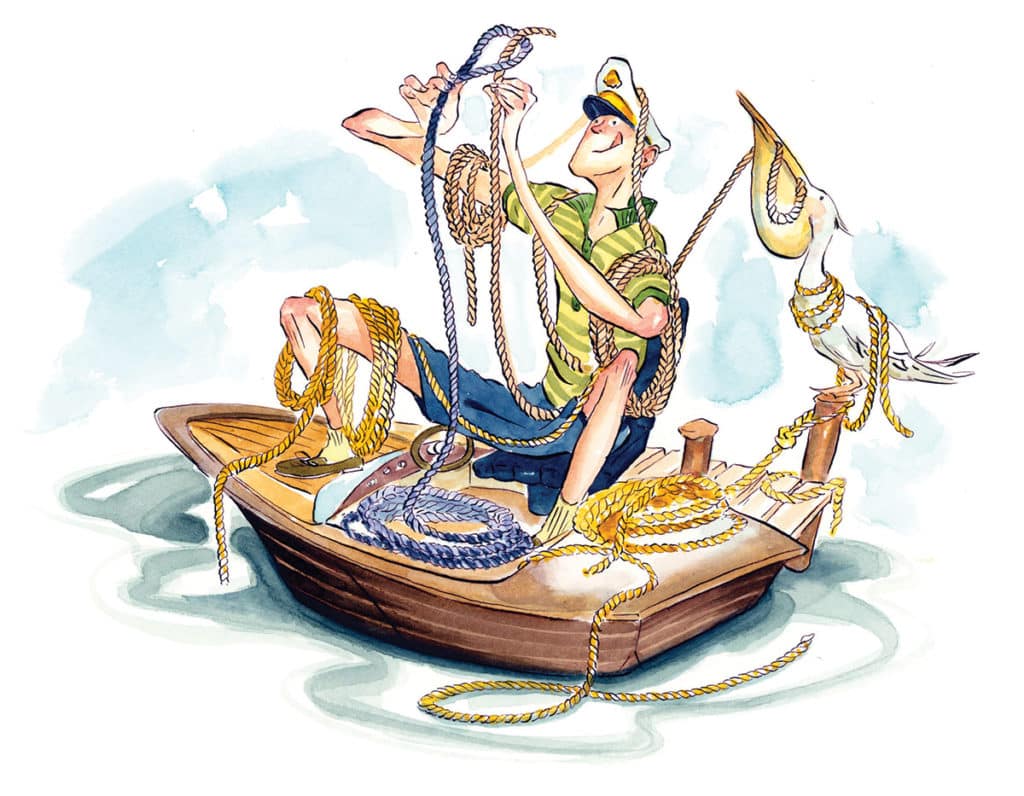
Do you know the old saying “Give a man enough rope and he’ll hang himself”? Give me enough rope and I’ll have an entertaining afternoon.
Actually, it’s more likely that if I give you enough rope you’ll hang yourself out of boredom. I bet the only knots you know are for a cleat and something to wrap around a piling. If you’re into fishing, maybe you’ll add in a Bimini twist.
Sure, you know that you need to learn a few more knots, but they’re soooo 19th century, confusing and way too hard to learn. Isn’t there an app for this stuff? Sorry, but no. (Although there’s an app to learn to tie them called Grog’s Animated Knots: $4.99 in the iTunes store.) While electronics have taken over almost everything on board, you’re still going to have to deal with ropes. Which isn’t so bad. In fact, it opens up interesting opportunities.
Granted, I say this from the perspective of a total boat geek, a member in good standing of the International Guild of Knot Tyers (yes, it’s for real) and a student of topology — a branch of math that studies knots within three-dimensional Euclidean space (take that Stephen Hawking).
So who needs more knots? You do. Because there are traditions of the sea that have stood the test of time, and one of them is knowing how to tie the right knot for a job. If you can’t, you’re not a sailor — a designation that has nothing to do with the kind of boat you operate.
If you knew how to tie a trucker’s hitch you’d be able to securely lash things down, like your dinghy. With a sheet bend you could join two lines — to make one long line — so they won’t come apart under strain but are still easily untied. A rolling hitch lets you tie on to the middle of a line, such as an anchor line, so two people can pull at the same time.
More? A constrictor knot can be used as an emergency replacement for a hose clamp or a tourniquet. If you could quickly tie a Spanish bowline you’d be able to haul an unconscious crew member back on board. Tie a few lineman’s loops in a long length of rope and you’ve got an instant rope ladder. A heaving line knot puts weight at the end of a line so it can be thrown a long distance to another boat or someone on a dock. And then there’s the jug sling, which is perfect for tying to a wine bottle so it can chill overboard.
There are a few hundred more, but there’s one I’m particularly fond of because I almost invented it: the adjustable eye splice. After thousands of years of knotting you’d figure we’d have discovered them all. And when I came up with my knot in the early ’60s, I thought so too. Still, after finding no mention of anything like it I thought I’d done it. But then, while looking through a book on witches’ knots (who knew?), I found a drawing of a “running eye splice on the byte.” Here was my knot, already recorded into history in 1714.
While it isn’t as strong as a true eye splice, it’s useful and a lot easier to tie. (Learn how at boatingmag.com/isplice.) After all this, I hope that when I see you outside the inlet, you’ll at least be able to tie a proper hangman’s noose. Hey, if you’re going to do it, at least do it right. Show some pride, sailor.









